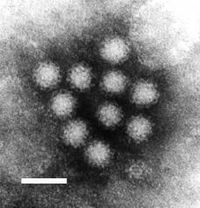
Photo from wikipedia
Human noroviruses (NoVs) are the most common cause of acute gastroenteritis worldwide. One major obstacle in developing NoV vaccines is the lack of robust cell culture for efficacy evaluation. In… Click to show full abstract
Human noroviruses (NoVs) are the most common cause of acute gastroenteritis worldwide. One major obstacle in developing NoV vaccines is the lack of robust cell culture for efficacy evaluation. In this study, we successfully developed a NoV virus-like particle (VLP) entry assay based on split NanoLuc luciferase (LgBiT and HiBiT) complementation. HiBiT-tagged NoV GII.4 VLP (VLP-HiBiT) can be efficiently produced in Pichia pastoris and retain binding activity towards NoV receptor histo-blood group antigens (HBGAs). A 293T-FUT2-LgBiT cell line was established and was shown to stably express cell surface HBGAs and intracellular LgBiT. GII.4 VLP-HiBiT can bind and enter into the 293-FUT2-LgBiT cells, producing strong luminescence signals in live cells. Anti-GII.4 sera can inhibit VLP-HiBiT entry into the 293-FUT2-LgBiT cells in a dose-dependent manner, and neutralizing titers well correlate with their blocking titers measured by HBGAs-binding blockade assay. Moreover, such a surrogate infection/neutralization assay can be applied to other NoV genotypes such as GI.1 and GII.17. Together, the VLP-HiBiT entry assay can mimic both NoV attachment and internalization in live cells and thus facilitate reliable and comprehensive evaluation of NoV vaccine and antibodies.
Journal Title: Antiviral research
Year Published: 2021
Link to full text (if available)
Share on Social Media: Sign Up to like & get
recommendations!